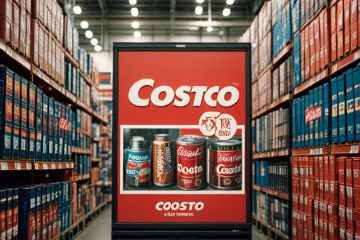Tim Hortons: Canadian Eh? Not Really

When you think of Canada, a few images instantly pop into your head—maple leaves, snow-covered landscapes, polite people, and of course, Tim Hortons. The red-and-white coffee cup is practically a cultural artifact. Hockey players sipping Timmies in the locker room? Check. Early morning commuters clutching double-doubles? Double check.
But here’s the real kicker—Tim Hortons isn’t really Canadian anymore. Sure, the branding is soaked in maple syrup and nostalgia, but peel back the cozy exterior and what you’ll find is a big, bold American business operation at its core. Yeah, the iconic Canadian coffee chain has gone full corporate, and its ownership story is one hell of a ride.
Let’s dig in.
1. The Origin Story: All Canadian Glory
Tim Hortons started like most legends do—in humble beginnings. Founded in 1964 in Hamilton, Ontario, by NHL defenseman Tim Horton and businessman Ron Joyce, the coffee shop quickly gained popularity for its simple menu and affordable pricing. Coffee and donuts? That’s it. No lattes with oat milk, no marketing gimmicks. Just straight-up Canadian comfort food.
Throughout the ’70s and ’80s, Tim Hortons grew fast, spreading across provinces like wildfire. For a long time, it was proudly and wholly Canadian-owned. It wasn’t just a brand; it was a part of Canadian identity. Every small town had a Timmies, and people wore the uniform like a badge of honour.
But as with most things in the corporate world, the plot thickens.
2. The American Takeover: Enter Wendy’s
Fast forward to 1995: the first big change. Tim Hortons was acquired by Wendy’s, the American fast-food chain. Yep, your local Timmies became an American asset. The merger made strategic sense at the time—Tim Hortons wanted to expand into the U.S., and Wendy’s wanted to tap into the Canadian market.
But not everyone was thrilled. The idea that a staple Canadian brand was now under U.S. control didn’t sit well with some patriotic customers. Still, the coffee was hot, the donuts were fresh, and people kept lining up.
3. Back to Canadian Hands? Not for Long
In 2006, Wendy’s spun off Tim Hortons through an IPO, and the brand returned to being a public Canadian company, trading on the Toronto Stock Exchange. For a hot second, Canadians felt like they had their brand back.
But that moment was short-lived.
4. The Game-Changer: Brazil’s 3G and Restaurant Brands International
In 2014, Tim Hortons was acquired by Burger King, which is owned by 3G Capital, a Brazilian investment firm. The merger formed Restaurant Brands International (RBI), a Canadian-headquartered but multinational conglomerate that also owns Popeyes and Firehouse Subs.
So while RBI is technically based in Canada, let’s not kid ourselves—this is a global operation run by multinational capital, not your friendly neighborhood coffee shop owner. 3G Capital is known for its aggressive cost-cutting, tight profit margins, and relentless expansion tactics. This isn’t the kind of cozy, hometown strategy people romanticize about.
5. So, Who Really Owns Tim Hortons?
Let’s break this down in plain terms:
| Year | Ownership | Country |
|---|---|---|
| 1964 | Tim Horton & Ron Joyce | Canada |
| 1995 | Wendy’s | USA |
| 2006 | Independent Public Company | Canada |
| 2014 | Burger King / RBI (3G Capital) | Brazil / Canada HQ, Global Ops |
Sure, RBI is headquartered in Oakville, Ontario, and technically trades on the TSX. But the financial muscle and decision-making come from global players, not some Timmy from Toronto.
6. Why This Matters: The Loss of Canadian Control
It’s not just about coffee. It’s about how many “Canadian” brands are slowly being swallowed up by international conglomerates. When foreign capital controls domestic companies, decisions get driven by spreadsheets, not community values.
Need proof? Just look at the decline in quality and customer satisfaction at Tim Hortons over the last decade:
- Menu confusion: From a basic coffee-and-donut setup to a Frankenstein of soups, burgers, and failed espresso drinks.
- Franchisee backlash: Many Canadian franchisees have pushed back against RBI’s aggressive cost-cutting, claiming the company is more focused on profits than product.
- Employee treatment: Multiple reports show labor issues, especially after minimum wage hikes. Some stores even clawed back paid breaks.
That’s not very Canadian, eh?
7. The Brand Still Feels Canadian — But That’s Marketing
Let’s not forget: RBI has expertly played into Canadian identity. Their ads are full of maple leaves, hockey references, and “true north” vibes. They name drinks after slang like “Double Double,” and drop campaigns about the military, Canadian winters, or long drives across the Prairies.
It’s brilliant branding. But it’s also a little manipulative.
Because while you’re watching a feel-good ad during Hockey Night in Canada, real decisions about the coffee you’re drinking are being made in Miami boardrooms or Brazilian hedge funds.
8. The Real Tea (or Coffee)
Let’s be clear—this isn’t about shaming globalization. Business is business. But let’s call it what it is: Tim Hortons is not a mom-and-pop Canadian brand anymore. It’s a fast-food product in a global portfolio of fast-food products.
Is that a bad thing? Not necessarily. Timmies still serves millions of Canadians every day. It still sponsors hockey tournaments. It’s still a spot where neighbors gather.
But if you’re sipping a Double Double thinking you’re supporting a 100% Canadian institution, you’re drinking the Kool-Aid—err, coffee.
9. What’s Next for Tim Hortons?
In 2025, Tim Hortons is doubling down on:
- Tech integration: App-based ordering, loyalty programs, and delivery partnerships.
- Global expansion: Stores in India, the Middle East, and China.
- “Innovation”: Expect more strange limited-time drinks and menu mashups. Churro lattes, anyone?
The focus is growth, not heritage. The vibe is corporate, not community.
10. What Happened to the Other “Canadian” Coffee Chains?
While Tim Hortons was going corporate and scaling globally, other homegrown Canadian coffee chains tried to carve out their piece of the pie. But if you’ve ever asked yourself, “What happened to Coffee Time, Second Cup, or Country Style?”—you’re not alone. Let’s break it down:
☕ Coffee Time: Stuck in the ’90s
Founded in 1982 in Bolton, Ontario, Coffee Time once had hundreds of locations across Ontario. It was known for being cheaper than Timmies and had a loyal working-class customer base—think construction crews, truckers, and late-night diners.
What Went Wrong:
- Outdated branding: Coffee Time never kept up with modern aesthetics. It felt stuck in the 1990s with its neon signs, plain interiors, and no clear identity.
- No digital game: No app. No mobile orders. Zero brand evolution.
- Intense competition: Timmies, Starbucks, and indie cafes squeezed it out from all sides.
- Poor franchisee support: Multiple store closures over the years and inconsistent experiences killed consumer trust.
Status in 2025: A handful of locations remain, mostly in small Ontario towns or sketchy city corners. It’s more of a relic than a contender.
☕ Second Cup: The “Almost Starbucks” That Lost the Plot
Second Cup started in 1975 in Toronto and was, at one point, Canada’s second-largest coffee chain. It aimed to be the Canadian version of Starbucks—fancy coffee, comfy seating, Wi-Fi, and espresso machines that hissed like steam trains.
What Went Wrong:
- Identity crisis: It never picked a lane. Was it a premium café? A neighborhood spot? A fast casual chain? Nobody could tell.
- Too slow to scale: While Starbucks expanded rapidly with tech and loyalty programs, Second Cup hesitated.
- Franchise struggles: Many franchisees struggled with profitability due to rising costs and lack of brand pull.
- Brand fatigue: It just never built the same emotional connection that Tims or Starbucks managed.
To reinvent itself, Second Cup rebranded under “Aegis Brands”, experimented with cannabis cafés, and later started selling assets. It’s no longer in the coffee spotlight.
Status in 2025: You’ll still find a few Second Cup cafés in malls or universities, but it’s no longer a serious player.
☕ Country Style: The Quiet Fade
Launched in 1963 in Toronto, Country Style actually predates Tim Hortons by a year. It was known for its rural-friendly name, cozy vibes, and classic menu: donuts, drip coffee, and breakfast sandwiches.
What Went Wrong:
- Lack of innovation: Country Style didn’t adapt when consumer expectations changed.
- Brand dilution: It got acquired by MTY Group, which owns dozens of food court brands (Mr. Sub, Thai Express, etc.). That led to a lack of focus.
- Store closures: Many locations converted into other MTY franchises or shut down altogether.
Status in 2025: It still exists—but barely. You might see one at a gas station or remote highway stop. It’s like a ghost of Canadian coffee past.
Tim Hortons — Only One Coffee Chain “Won” the Canadian Market, But It Ain’t Really Canadian
| Brand | Peak Era | What Killed It | 2025 Status |
|---|---|---|---|
| Coffee Time | 1990s | Outdated, ignored digital shift | Hanging by a thread |
| Second Cup | Early 2000s | Identity crisis, poor innovation | Barely around, not relevant |
| Country Style | 1970s–1990s | No growth strategy, lost to MTY | Highway rest stops, mostly dead |
| Tim Hortons | Ongoing | Sold to global investors, still dominant | Dominates Canada, but not Canadian-owned |
Real Talk
Canada had a chance to build a coffee empire rooted in its own culture and values. But due to slow innovation, corporate buyouts, and branding mistakes, most of the original players either died off or became zombies. Only Tim Hortons scaled—and that came at the cost of selling out.
Moral of the story? If we want truly Canadian brands to survive, we need to support innovation and independence. Because once Wall Street and private equity get involved, it’s game over for authenticity.
Want more AI-driven finance tips? Subscribe to our blog and stay ahead of the game!
Disclaimer: This blog article is for informational purposes only and should not be considered financial advice. Everyone’s financial situation is unique. Always consult with a qu



0 Comments